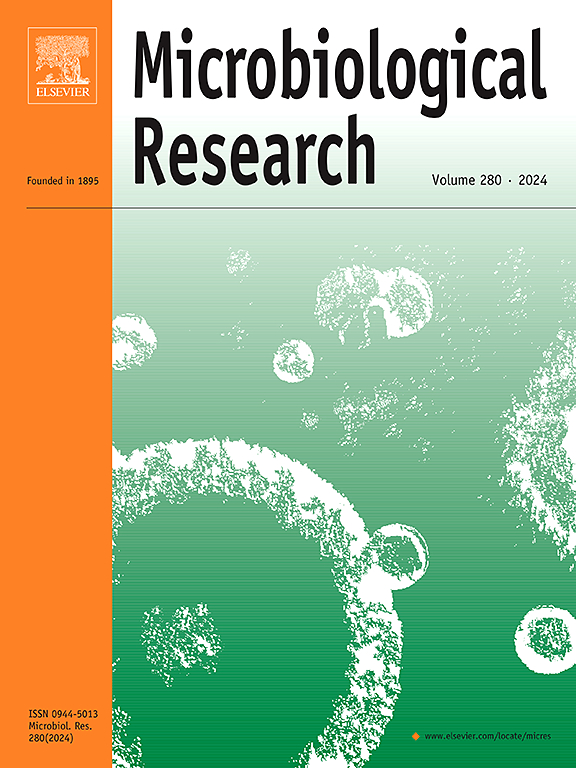Inhibition of calpain reduces oxidative stress and attenuates pyroptosis and ferroptosis in Clostridium perfringens Beta-1 toxin-induced macrophages
IF 6.1
1区 生物学
Q1 MICROBIOLOGY
引用次数: 0
Abstract
Clostridium perfringens Beta-1 toxin (CPB1) is a lethal toxin, which can lead to necrotic enteritis, but the pathological mechanism has not been elucidated. We investigated whether reactive oxygen species (ROS) participated in CPB1-induced pyroptosis and ferroptosis, and investigated the effects of calpain on CPB1-induced oxidative stress and inflammation. Scavenging ROS by N-Acetyl-L cysteine (NAC) led to the reduction of ROS, inhibited the death of macrophages, cytoplasmic swelling and membrane rupture, the expression of pyroptosis-related proteins and proinflammatory factor, while increased the expression of anti-inflammatory factors in cells treated with rCPB1. Adenosine triphosphate (ATP) synthase, H+ transporting, mitochondrial F1 complex, alpha subunit 1 (ATP5A1) was identified specifically interact with rCPB1. Silencing ATP5A1 inhibited accumulation of ATP and ROS, leaded to less cytoplasmic swelling and membrane rupture, attenuated pyroptosis and inflammation in rCPB1-treated cells. We also found that rCPB1 induces ferroptosis in macrophages, and the level of ferroptosis was similar with H2O2. Of note, H2O2 is a major ROS source, indicated that ROS production may play a major role in the regulation of ferroptosis in macrophages treated with rCPB1. This finding was further corroborated in rCPB1- induced human acute monocytic leukemia cells, which were treated with NAC. In addition, the inhibition of ferroptosis using liproxstatin-1 inhibited the shriveled mitochondrial morphology, increased the expression of glutathione peroxidase 4, nicotinamide adenine dinucleotide (phosphate) hydrogen: quinone oxidoreductase 1 and cysteine/glutamic acid reverse transport solute carrier family 7 members 11, decreased the expression of heme oxygenase 1, nuclear receptor coactivator 4 and transferrin receptor proteins, reduced malondialdehyde and lipid peroxidation levels, and increased intracellular L-glutathione levels in cells treated with rCPB1. Furthermore, calpain inhibitor PD151746 was used to investigate how pyroptosis and ferroptosis were involved simultaneously in rCPB1-treated macrophages. We showed that PD151746 inhibited ATP and ROS production, reversed the representative pyroptosis/ferroptosis indicators and subsequently reduced inflammation. The above findings indicate that rCPB1 might lead to macrophage pyroptosis and ferroptosis through the large and sustained increase in intracellular calpain and oxidative stress, further lead to inflammation.
抑制钙蛋白酶可降低氧化应激,减轻产气荚膜梭菌 Beta-1 毒素诱导的巨噬细胞的热蛋白沉积和铁蛋白沉积。
产气荚膜梭菌β-1毒素(CPB1)是一种致命毒素,可导致坏死性肠炎,但其病理机制尚未阐明。我们研究了活性氧(ROS)是否参与了 CPB1 诱导的热变态反应和铁变态反应,并探讨了钙蛋白酶对 CPB1 诱导的氧化应激和炎症的影响。用N-乙酰-L-半胱氨酸(NAC)清除ROS可减少ROS,抑制巨噬细胞的死亡、细胞质肿胀和膜破裂,抑制热凋亡相关蛋白和促炎因子的表达,同时增加经rCPB1处理的细胞中抗炎因子的表达。三磷酸腺苷(ATP)合成酶、H+转运、线粒体 F1 复合体α亚基 1(ATP5A1)与 rCPB1 有特异性相互作用。沉默 ATP5A1 可抑制 ATP 和 ROS 的积累,减少细胞质肿胀和细胞膜破裂,减轻 rCPB1 处理细胞的脓毒症和炎症。我们还发现,rCPB1 能诱导巨噬细胞中的嗜铁细胞,其嗜铁水平与 H2O2 相似。值得注意的是,H2O2 是一种主要的 ROS 来源,这表明 ROS 的产生可能在调节经 rCPB1 处理的巨噬细胞的铁卟啉沉积过程中发挥了重要作用。这一发现在用 NAC 处理的 rCPB1 诱导的人急性单核细胞白血病细胞中得到了进一步证实。此外,使用脂氧司他丁-1 抑制铁变态反应可抑制线粒体形态的萎缩,增加谷胱甘肽过氧化物酶 4、烟酰胺腺嘌呤二核苷酸(磷酸)氢、醌氧化还原酶的表达:醌氧化还原酶 1 和半胱氨酸/谷氨酸反向转运溶质运载家族 7 成员 11 的表达,降低血红素加氧酶 1、核受体辅激活因子 4 和转铁蛋白受体蛋白的表达,降低丙二醛和脂质过氧化水平,并增加细胞内 L-谷胱甘肽的水平。此外,我们还使用钙蛋白酶抑制剂 PD151746 来研究 rCPB1 处理的巨噬细胞如何同时参与了热蛋白沉积和铁蛋白沉积。我们发现,PD151746 抑制了 ATP 和 ROS 的产生,逆转了具有代表性的热蛋白沉积/铁蛋白沉积指标,从而减轻了炎症。上述研究结果表明,rCPB1 可通过细胞内钙蛋白酶和氧化应激的大量持续增加导致巨噬细胞热噬和铁噬,并进一步引发炎症。
本文章由计算机程序翻译,如有差异,请以英文原文为准。
求助全文
约1分钟内获得全文
求助全文
来源期刊

Microbiological research
生物-微生物学
CiteScore
10.90
自引率
6.00%
发文量
249
审稿时长
29 days
期刊介绍:
Microbiological Research is devoted to publishing reports on prokaryotic and eukaryotic microorganisms such as yeasts, fungi, bacteria, archaea, and protozoa. Research on interactions between pathogenic microorganisms and their environment or hosts are also covered.
 求助内容:
求助内容: 应助结果提醒方式:
应助结果提醒方式:


